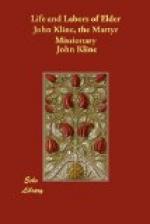Every true child of God possesses two distinct natures. A knowledge of this wonderful truth lies within the range of every one’s experience. But it is equally confirmed by divine revelation. Paul calls the one nature or consciousness the OUTWARD MAN, and the other the INWARD MAN. The one bears the image of the first Adam, and is of “the earth earthy;” the other bears the image of the last Adam who is the Lord, “and is heavenly.” Esau represents the first; and, as such, he can not inherit the heavenly birthright, because he is carnal, and “flesh and blood cannot inherit the kingdom of heaven.”
As the antitype of this great truth which underlies the scheme of redemption, God could not but “hate Esau,” because “the lust of the flesh, and the lust of the eyes, and the pride of life, are not of the Father, but are of the world.” “But Jacob he loved,” because Jacob is the child “born of God” in the image of our Lord Jesus Christ, “the inner man,” which after God, is “created in righteousness and true holiness.” “The elder shall serve the younger.” This means that “the natural body” must be brought under subjection and serve “the spiritual body.” For “there is a natural body” first born, and “there is a spiritual body” last born.
In another place Paul uses lofty terms to designate these two. He there calls the one “the earthly house of this tabernacle,” which must perish; the other “a building of God, a house not made with hands”—God’s hands—“eternal in the heavens.” The reason why he says “in the heavens” is because it is in the light of heaven; just as he says in another place, “We have been made to sit together in heavenly places,” by which he correlatively means just the same that we mean when we say we sit in the sun, meaning that we sit where the light of the sun shines upon us.
Now, Brethren beloved, I have been very brief on a subject that might be profitably expanded into a volume. I hope that I have given you points by which you may take the subject and think upon it for yourselves; and thus add faith to faith, and knowledge to knowledge. May God add his blessing to what I have said, that it may prove to be strength in much weakness.
During the interval between the twenty-fourth and the twenty-eighth, Brother Kline visited many Brethren in Augusta County, Virginia.
THURSDAY, April 28, he attended a love feast at the brick meetinghouse. Of this he says: “The afternoon meeting was well attended. The second chapter of Peter’s first letter was read. Much good instruction for self-examination was given, both in German and English, from the general scope of the chapter. I made a few remarks on the middle clause in the seventeenth verse: ‘Love the brotherhood.’
“I fear we do not speak and exhort one another as plainly and warmly as we should on this most essential part of every true believer’s experience and life. What keeps us a united and happy people? Love of the Brotherhood. What keeps us from quarreling with one another, from slandering and defrauding one another? Love of the Brotherhood. What keeps alive our sympathies for each other in times of distress and in seasons of sorrow? Love of the Brotherhood.




